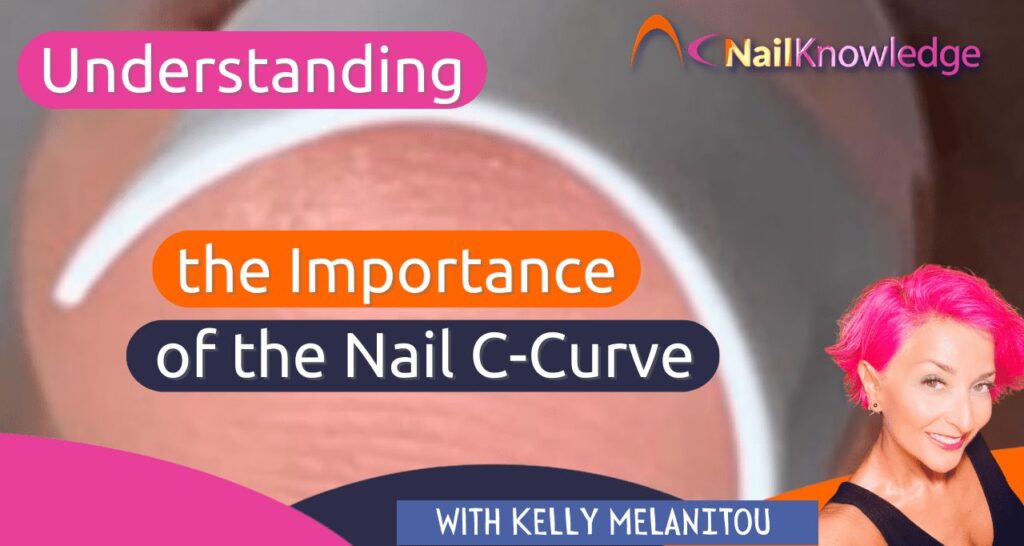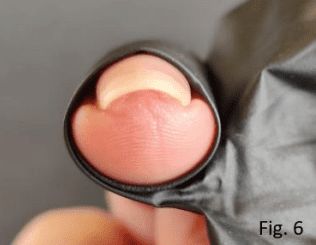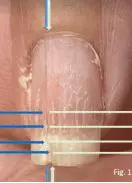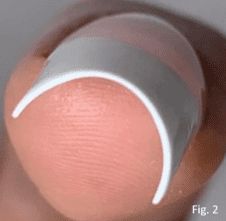How Can We Help?

The Nail C-Curve
17.4k Views
The Nail C-Curve: Understanding the Basics
What is this the C-Curve?
The nail C-Curve refers to the natural curvature of the nail plate from one sidewall to the other. It gets its name from the shape it forms, resembling the letter “C.” The C-curve is an essential aspect of nail aesthetics and health, as it contributes to the overall appearance and strength of the nails.
Importance of the C-Curve
A well-defined C-curve is crucial for several reasons
- It gives nails a visually appealing shape.
- It provides structural support, preventing breakage or splitting.
- It protects the distal phalanx and helps avoid injury.
Factors Affecting the C-Curve
The C-curve can be influenced by various factors, including genetics, nail care habits, and nail enhancements. It’s essential to recognize these factors to understand how to manage and handle coatings that will help with restructuring the C-form, if necessary.
The Science Behind the Nail C-Curve
Nail Anatomy
To comprehend the C-curve, it’s helpful to know some basic nail anatomy. The nail plate is the hard, protective layer on the surface of the finger or toe. It is composed of keratin, a protein that also makes up hair and skin. The nail bed is the soft tissue beneath the nail plate, and the matrix is the area responsible for nail growth.
How the C-Curve Forms
The C-curve is determined by the shape of the nail matrix and the distal phalanx, which dictates the nail plate’s curvature. As the nail grows, the matrix produces keratin cells, which are pushed outwards and harden to form the nail plate. The pressure exerted by the surrounding skin also contributes to the formation of the C-curve.
Nail C-Curve Variations
There are three primary types of C-curves, each with its unique characteristics.
Flat C-Curve
A flat C-curve has minimal curvature and is more prone to breakage. This type of nail may be a result of genetics, injury, a skin disorder such as psoriasis or eczema or poor nail care habits. A variation to the flat C-curve would be one with deep sidewalls, resulting in a shape closer to a “π” instead of a C.

Moderate C-Curve
A moderate C-curve has a balanced curvature, providing ample strength and a visually appealing shape. This type of nail is generally healthy and resilient.

Deep C-Curve
A deep C-curve has a pronounced curve, which can result in increased strength but may also lead to issues like ingrown nails. This type of nail can be genetic or caused by improper nail care techniques.

How to Enhance or Correct the C-Curve
If you’re unsatisfied with your natural C-curve or experiencing issues due to its shape, there are several ways to enhance or correct it.
Nail Enhancements
Nail enhancement products, such as liquid & powder, gel, or polygel, can be used to create a more pronounced C-curve. A skilled nail technician can sculpt the extension to the desired curvature, providing a visually appealing and durable nail. This can be done using a tip, but more successfully by using a nail form.
Using Nail Forms
Nail forms are used to create a custom shape for the nail extension. By adjusting the form’s placement and curvature, a nail technician can achieve the desired C-curve for the client.
Nail Pinching Technique
The nail pinching technique is a method used by nail technicians to create or enhance the C-curve in natural nails or extensions. This technique involves applying gentle pressure to the sides of the nail to narrow its width and create a more defined curve.
It’s essential to ensure that the pinching is done correctly to avoid damaging the nail or causing discomfort. Because it is a delicate procedure that can cause damage, many nail professionals are opting to use more sturdy nail forms that hold their shape, and they pinch those prior to product application, instead of pinching the enhancement itself.
We would not recommend doing this yourself, we have seen serious damage caused by pinching with too much pressure as in this picture where the nail matrix itself was torn in two and now it produces two halves of a nail plate!


but needs to be done by a professional – these extreme nail enhancements are made for competion and should not be tried without proper training as they could cause damage such as Fig 1.
Maintaining a Healthy Nail C-Curve
Proper nail care is crucial for preserving a healthy C-curve and preventing nail-related issues. Follow these tips to maintain your nail health.
Keep your nails clean and dry
- Avoid using harsh chemicals.
- Trim your nails regularly, using no higher grit than 240.
- Moisturize your nails and surrounding skin with a cuticle oil or cream.
- Wear gloves when doing household chores and gardening to protect your nails.
When to Seek Professional Help
If you’re experiencing persistent issues with your nails, such as pain, inflammation, or an unusual C-curve shape, consult a professional nail technician or dermatologist. They can help diagnose the issue and recommend appropriate treatment or maintenance strategies.
Understanding Variations and Factors Affecting Your Nails
The nail C-curve plays a significant role in the appearance and health of your nails. Understanding its importance, variations, and factors that affect it is essential for maintaining strong, healthy, and beautiful nails. Remember to practice proper nail care and seek professional help if you experience any issues.
Some common FAQs we are asked on the website
What is the nail C-curve?
The nail C-curve refers to the natural curvature of the nail plate from one side to the other, resembling the letter “C.”
Why is the C-curve important?
The C-curve contributes to the overall appearance and strength of the nails, providing structural support and protecting the distal phalanx.
What factors affect the C-curve?
The C-curve can be influenced by genetics, nail care habits, and nail enhancements.
What are the types of nail C-curves?
There are three primary types of C-curves: flat, moderate, and deep. Each has its unique characteristics and may require different care and maintenance.
How can I enhance or correct my nail C-curve?
Methods to enhance or correct the C-curve include nail enhancements using nail forms or tips. It’s essential to consult a professional nail technician for the best results.
